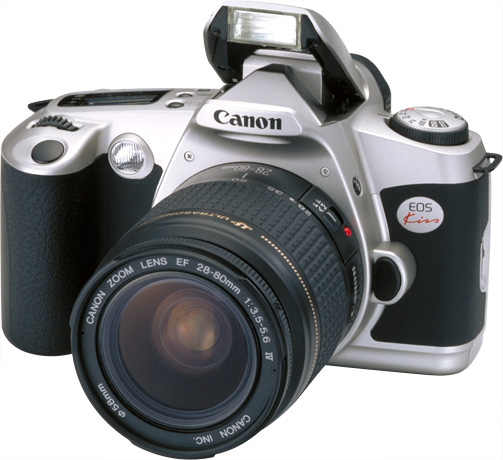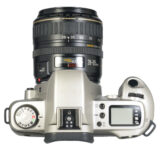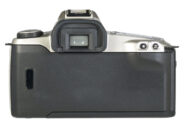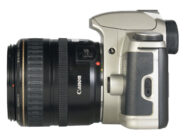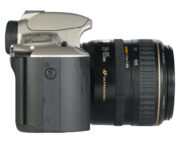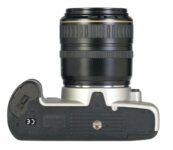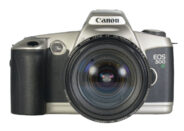Canon EOS Rebel G
aka Canon EOS 500N
aka Canon New EOS Kiss
35mm AF film SLR camera
Specification
| Production details: | |
| Announced: | September 1996 |
| System: | ● Canon EOS (1987) |
| Format: | |
| Maximum format: | 35mm full frame |
| Film type: | 135 cartridge-loaded film |
| Mount and Flange focal distance: | Canon EF [44mm] |
| Shutter: | |
| Type: | Focal-plane |
| Model: | Electronically controlled |
| Speeds: | 30 - 1/2000 + B |
| Exposure: | |
| Exposure metering: | Through-the-lens (TTL), open-aperture |
| Exposure modes: | Programmed Auto |
| Aperture-priority Auto | |
| Shutter-priority Auto | |
| Manual | |
| Physical characteristics: | |
| Weight: | 400g |
| Dimensions: | 146x92x62mm |
Manufacturer description #1
Lake Success, N.Y., July 29, 1996-- Canon U.S.A., Inc. is expanding its revolutionary camera design concept into a new generation EOS Rebel. The Rebel G, available in two versions, including a Quartz Date model, raises the standard of the world's best selling SLR camera with its new and improved camera features.
The EOS Rebel G is a fully automatic, ultra-compact and quiet 35mm AF SLR camera with a built-in, retractable flash. It features a high-speed selectable 3-point autofocus system with Al Focus for improved performance and utilizes Canon's exclusive AIM (Advanced Integrated Multi-Point) control system which links the camera's 3-point autofocus to multi-zone metering for available light and flash. The New Rebel G offers users 11 exposure modes from Full Auto to metered manual, plus multiple manual, plus multiple exposure, exposure compensation and Auto Exposure Bracketing (AEB).
The camera also incorporates a brighter viewfinder based on new mirror coating technology and features E-TTL metering functions when used in conjunction with that Canon Speedlite 380 EX or new 220EX.
The Rebel G offers exceptional ease-of-use with an enhanced Command Dial for the selection of operating modes and remains fully compatible with Canon's line of EF autofocus lenses and EOS System Speedlites. It will also be compatible with popular Rebel-series accessories including the Battery Pack BP-8, Grip Tripod GR-80TP, and Remote Switch RS-60E3.
"The tradition of quality found in the EOS Rebel-series cameras will be enhanced with the introduction of the new Rebel G," said Ted Ando, director and general manager of Canon's Camera Division. "The new Rebel G will take 35mm photography to a higher level while expanding on the user-friendly design, versatility and highly attractive balance of price and performance that have made the EOS Rebel so popular. The combination of affordability, extended features and performance of the Rebel G will make it ideal for a wide range of 35mm photography enthusiasts," Mr. Ando added.
The EOS Rebel G incorporates the latest Canon innovations and offers the following new features and improvements:
New Features
Selectable 3-Point Autofocus: The Rebel G incorporates the same 3-point autofocus capabilities as the EOS Elan II and IIE models. Utilizing the camera's three-zone autofocus system, the BASIS (Base Stored Image Sensor) system features a cross-type sensor at the center, coupled with vertical line sensors to the left and right, which enable the camera to anticipate changes in the subject's position. The focusing points can be camera or user selected using the focusing point selector button on top of the camera. The viewfinder LCD panel displays the active focusing point at all times.
Auto Exposure Bracketing (AEB): The Rebel G offers users auto exposure bracketing, a feature normally found in more expensive SLR models. Bracketing is possible in 1/2 stop increments up to ą2 stops.
E-TTL Autoflash: Originally found on the more feature-laden EOS Elan II/IIE, the E-TTL system provides a natural balance between subject and background and also enables high-speed synch for automatic fill flash as well as FE (flash exposure) lock when used with the Canon Speedlite 380EX or new 220EX. If a Canon Speedlite not compatible with E-TTL autoflash is used, A-TTL or TTL autoflash is available.
Night Scene: The camera incorporates a fully automatic slow-synchro flash feature that provided opportunities for combining beautiful sunsets with striking portraits. During exposure. A slow shutter speed is used to record backgrounds such as sunsets with natural light, while the slow-synchro flash "freezes" the subject in the foreground, providing a perfect balance of natural and artificial light. Night Scene can also be used in conjunction with the new Speedlite 220EX or any other EOS Speedlite.
Brighter View Finder: New mirror-coating technology offers users a brighter viewfinder equivalent to the brightness associated with a pentaprism. Incorporating this brightness level into a roof prism has allowed the Rebel G to maintain its ultra-compact design while providing users with better, more comfortable viewing system.
Improved Features
Metered Manual: The Rebel G incorporates a metered manual indicator, making manual exposures easier to set.
Partial Metering and Auto Exposure (AE) Lock: In the past, it was necessary to press the camera's metering/AE button during the time of exposure. The new Rebel G allows the AE button to be pressed anytime and stores the exposure information for 4 seconds after the button is released, greatly simplifying the process.
Red-Eye Reduction: In the Past, cameras offering red-eye reduction features would not allow users to release the shutter during the pre-exposure red-eye reduction cycle, often causing them to miss a great shot. With the new Rebel G, pressing the shutter button half-way initiates red-eye reduction. Pressing the shutter completely releases the shutter immediately, overriding the red-eye flash lock mechanism. This gives photographers the advantage of having more control over shutter release timing.
In-Focus Beeper: With certain camera models the in-focus beeper could only be switched on or off while in specific shooting modes. The Rebel G allows users to now turn the in-focus beeper on or off in all modes including Full Auto and Programmed Image Control modes.
The EOS Rebel G will be available in September (body only). The Rebel G kit includes the Canon EF 35-80mm f/4-5.6 III lens. A Quartz Date version of the Rebel G will be available in October in a traditional chrome body version.
Manufacturer description #2
The latest addition to the world's best selling line of SLR cameras, the EOS 500N is fully automatic, ultra compact, quiet and comes equipped with a built-in retractable flash.
It features a high-speed selectable 3-point autofocus system with AI Focus for improved performance, and Canon's exclusive AIM (Advanced Integrated Multi-point) control system which links EOS 500N's three-point autofocus to multi-zone metering for available light and flash.
Offering 11 exposure modes (Full Auto to metered manual) plus Multiple Exposure, Exposure Compensation and Auto Exposure Bracketing, it has an enhanced Command Dial for operating mode selection, and is fully compatible with Canon's complete line of EF autofocus lenses and EOS System Specialties.
New features like Auto Exposure Bracketing (in 1/2 stop increments up to ą 2 stops) and E-TTL Autoflash (enables high-speed sync for automatic fill flash), and improvements like better control of Red-Eye Reduction, the In-Focus Beeper and the Auto Exposure (AE) Lock make the EOS 500N the most advanced EOS yet.
Manufacturer description #3
The original EOS Kiss became a hit product due to its high-end features, easy operation, and affordable price. It was succeeded by the New EOS Kiss (EOS Rebel G or 500N in other countries). While inheriting the main features of the original Kiss such as lightweight and compact size, the New EOS Kiss has a Multi-BASIS (|+|) AF sensor for 3 focusing points displayed in the viewfinder’s image area. The focusing point can be selected manually by the user or automatically by the camera. Focusing the desired subject can be as quick as a more expensive camera. The following picture-taking modes can be set: Shutter speed-priority AE, aperture-priority AE, shiftable Intelligent program AE, Programmed Image Control modes, depth-of-field AE, program flash AE, and metered manual. The camera comes in silver or black.
Table of contents
Clickable
Canon EOS system cameras
Clickable
- Canon EF-M
- Canon EOS 10 S
- Canon EOS 10D
- Canon EOS 1D
- Canon EOS 1D mark II
- Canon EOS 1D mark II N
- Canon EOS 1D mark III
- Canon EOS 1D mark IV
- Canon EOS 1D X
- Canon EOS 1D X Mark II
- Canon EOS 1D X Mark III
- Canon EOS 1Ds
- Canon EOS 1Ds mark II
- Canon EOS 1Ds mark III
- Canon EOS 3
- Canon EOS 3000
- Canon EOS 5000
- Canon EOS 5D
- Canon EOS 5D mark II
- Canon EOS 5D mark III
- Canon EOS 5D mark IV
- Canon EOS 5Ds
- Canon EOS 5Ds R
- Canon EOS 620
- Canon EOS 630
- Canon EOS 650
- Canon EOS 6D
- Canon EOS 6D Mark II
- Canon EOS 700
- Canon EOS 750 QD
- Canon EOS 850
- Canon EOS A2
- Canon EOS D30
- Canon EOS D60
- Canon EOS ELAN
- Canon EOS ELAN 7E
- Canon EOS ELAN 7NE
- Canon EOS ELAN II
- Canon EOS IX
- Canon EOS IX Lite
- Canon EOS Rebel 2000
- Canon EOS Rebel G
- Canon EOS Rebel K2
- Canon EOS Rebel S II QD
- Canon EOS Rebel T2
- Canon EOS Rebel Ti
- Canon EOS Rebel X
- Canon EOS Rebel XS
- Canon EOS Rebel XS N DATE
- Canon EOS RT
- Canon EOS-1
- Canon EOS-1N
- Canon EOS-1N RS
- Canon EOS-1V
